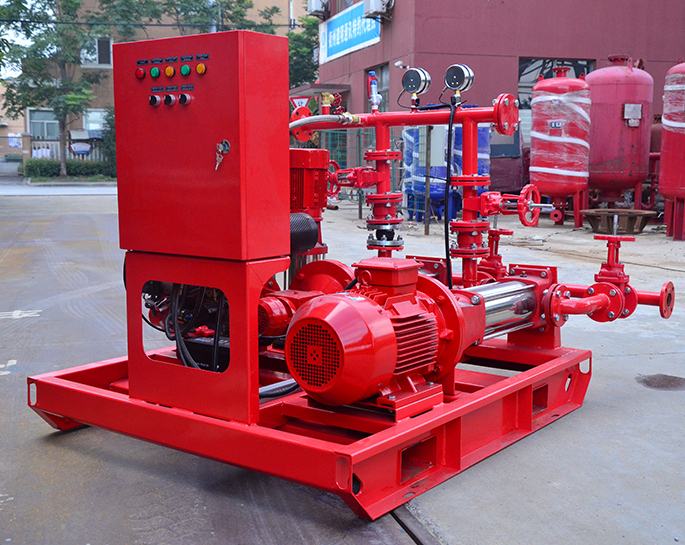What are some common maintenance tasks for fire pump sets?
Feb 28, 2024
Share:
Maintaining fire pump sets is crucial for ensuring their reliability and effectiveness during emergencies. Here are some common maintenance tasks for fire pump sets:
1. **Regular Inspections**: Conduct routine visual inspections of the fire pump set and its components to check for signs of damage, leaks, or corrosion. Inspect electrical connections, belts, couplings, and valves for any abnormalities.
2. **Testing Alarms and Controls**: Regularly test the alarms, gauges, pressure switches, and control panels to ensure they are functioning correctly. This includes testing the pump start-up sequence, alarm signals, and automatic shutdown mechanisms.
3. **Lubrication**: Lubricate moving parts such as bearings, shafts, and seals according to the manufacturer's recommendations to prevent friction and wear.
4. **Flow Testing**: Perform flow tests periodically to verify that the fire pump set can deliver the required flow rate and pressure to the fire protection system. This ensures that the system meets regulatory standards and can effectively suppress fires.
5. **Electrical System Inspection**: Check the electrical components, including wiring, connections, and motor windings, for signs of wear, overheating, or damage. Ensure that the electrical system is properly grounded and protected against voltage spikes.
6. **Cleaning**: Keep the pump, motor, and surrounding area clean and free of debris, dust, or obstructions that could impede airflow or cause overheating.
7. **Battery Maintenance**: If the fire pump set includes backup batteries for emergency power, regularly inspect and test the batteries to ensure they are fully charged and operational.
8. **Seal Inspection**: Inspect seals and gaskets for signs of deterioration or leakage. Replace any worn or damaged seals to prevent water leakage and maintain pump efficiency.
9. **Suction and Discharge Valve Inspection**: Check the suction and discharge valves for proper operation, tightness, and leaks. Lubricate valve stems and packing glands as needed.
10. **Record Keeping**: Maintain detailed records of maintenance activities, inspections, test results, and any repairs performed on the fire pump set. This documentation helps track the system's performance over time and ensures compliance with regulatory requirements.
By performing these maintenance tasks regularly and diligently, you can help ensure that fire pump sets remain in optimal condition and ready to respond effectively to fire emergencies.

1. **Regular Inspections**: Conduct routine visual inspections of the fire pump set and its components to check for signs of damage, leaks, or corrosion. Inspect electrical connections, belts, couplings, and valves for any abnormalities.
2. **Testing Alarms and Controls**: Regularly test the alarms, gauges, pressure switches, and control panels to ensure they are functioning correctly. This includes testing the pump start-up sequence, alarm signals, and automatic shutdown mechanisms.
3. **Lubrication**: Lubricate moving parts such as bearings, shafts, and seals according to the manufacturer's recommendations to prevent friction and wear.
4. **Flow Testing**: Perform flow tests periodically to verify that the fire pump set can deliver the required flow rate and pressure to the fire protection system. This ensures that the system meets regulatory standards and can effectively suppress fires.
5. **Electrical System Inspection**: Check the electrical components, including wiring, connections, and motor windings, for signs of wear, overheating, or damage. Ensure that the electrical system is properly grounded and protected against voltage spikes.
6. **Cleaning**: Keep the pump, motor, and surrounding area clean and free of debris, dust, or obstructions that could impede airflow or cause overheating.
7. **Battery Maintenance**: If the fire pump set includes backup batteries for emergency power, regularly inspect and test the batteries to ensure they are fully charged and operational.
8. **Seal Inspection**: Inspect seals and gaskets for signs of deterioration or leakage. Replace any worn or damaged seals to prevent water leakage and maintain pump efficiency.
9. **Suction and Discharge Valve Inspection**: Check the suction and discharge valves for proper operation, tightness, and leaks. Lubricate valve stems and packing glands as needed.
10. **Record Keeping**: Maintain detailed records of maintenance activities, inspections, test results, and any repairs performed on the fire pump set. This documentation helps track the system's performance over time and ensures compliance with regulatory requirements.
By performing these maintenance tasks regularly and diligently, you can help ensure that fire pump sets remain in optimal condition and ready to respond effectively to fire emergencies.


.png)
.png)

.png)


